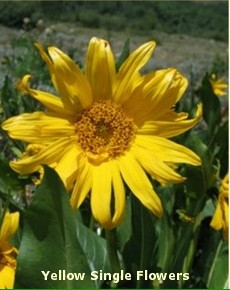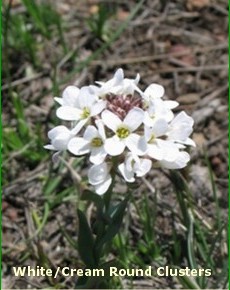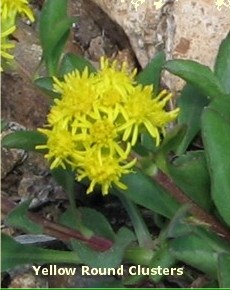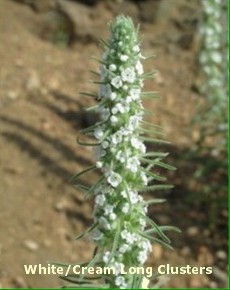
The primary purpose of this guide is to enable you to quickly and easily identify a plant, but also to give you an appreciation of the amazing diversity and beauty of the flowers that flourish here, the land that nurtures them and their need for protection. Rather than thumbing through pages of flowers in a book looking for something that looks like what you are looking at, let your electronic device make the search using the color and form of the flower, or using words to describe the flower and its environs. See How To for more information on using this guide.
This is my online record of the flora of the Southern Rocky Mountains. I have found flora in the Gunnison, San Isabel, Santa Fe, Rio Grande, Carson and San Juan National Forests, and also walking to the Post Office. The website began life as a CD called Wildflowers of the Gunnison Basin thus many of the 1,119 flowers, grasses, shrubs and trees were found in the mountains and valleys north of Almont, Colorado where the East and Taylor Rivers converge to become the Gunnison River which flows on to join the Colorado River. Springs and seasonal snow-melt from the high peaks that surround the valleys provide plenty of moisture. More species were found east of the Continental Divide in the rugged canyons and foothills of the Wet Mountains and south in the arid arroyos and mesas, lakes and rivers of northern New Mexico. I have included a very few species from the Colorado Plateau which presented themselves to me in my wanderings.
See Where the flowers grow for more detail and photographs of the life zones covered in this guide. The diversity of the terrain yields an incredible variety of plant life from the rugged cacti of the canyons to the tiny forget-me-not of the alpine tundra. Many of these plants can also be found throughout the Rocky Mountains and in other areas of North America, and indeed the World. Magnificent, spectacular, awesome, breathtaking, gorgeous, beautiful; there are not enough superlatives to describe these wild and wonderful places and the glorious flowers that grow here. This is not a complete list of all the flora that can be found in this region, it presents only the flowers that I have personally seen, photographed and identified.
About the photographs
I have attempted to show images of the flowers that uniquely identify them. This may be simply the flower but could include the leaves, fruit or shape in its natural setting to make identification more certain.
There are more than 2,400 images in this website. Almost 100% of the photos were taken with a digital camera; very few now are scanned slides or prints. All of the photographs were taken by me, unless credited otherwise. None of the photos have been digitally altered except to crop the original image to a suitable size.
The photos on the website may be used for personal or academic purposes as long as they are clearly credited to rockymountainsflora.com.
For full-size, high-resolution photographs or to use the photos for commercial purposes, please email me for permission and prices. The sale of photos is used to keep this guide updated and available.
About the creator
I am Marilyn Phillips, a native of England, whose love of nature and the outdoors from childhood brought me by a circuitous route to Crested Butte, Colorado in 1993 and 16 years later to northern New Mexico. My exploration of the many trails in these areas, my interest in wildflowers and photography, and career in computer system design came together in this creation.
How to use this Guide
Using this guide you will quickly be able to identify a flower. There are three ways to search:
search for the color and shape of the flower or plant type using imagessearch using words to describe the plant If you are familiar with plant families, there is list of families by scientific name and a list of families by common name which lists all the plants in the family with links to their descriptionsIf you are unable to identify the flower in this guide, you can take photographs of it and email me. Please read How to Photograph Wildflowers for Identification for tips.
Search Using Images
The home page of this guide presents you with 16 photos, each of which represents a group of flowers sharing similar color or form, for example, blue single flowers, yellow round clusters of flowers, or grasses and trees. Click on the image which is closest to the plant that you want to identify and you will see a page of all the flowers in the group. This index gives you an up-close image of the flowers. For a description and another photo of the flower, the whole plant and distinguishing characteristics, click the flower's image.
The decision on whether to designate the form of a flower as round, long or single was not always easy, even the colors were sometimes difficult; yellow or green, pink or red? So if you do not find a flower where you expect it to be, try another group.
The rough definitions for the flower forms are:
Single - Flowers that are on a single stem and stand out separately from other flowers, e.g. Blue Flax and SunflowersRound Clusters - Many, usually small, flowers clustered together in a round or flat shape, e.g. Wallflower and Rosy PaintbrushLong Clusters - Many flowers clustered either loosely or tightly along a stem, e.g. Bistort and FireweedThere is not a large variety of red and orange flowers so I have grouped them all together. Lavender/lilac colored flowers are grouped with blue and purple flowers.
Flowers can appear in more than one group. Some flowers that have a range of colors will appear in the index for both ends of the range, usually white and blue. The flowering trees in the Trees index page also appear in their respective groups by color and form of their flowers.
When there are similar looking flowers in the same family, the most frequently found will be in the group index page, for example, Chiming Bells; when you click on it, you will see five kinds of Chiming Bells.
Welcome to the profusion of wildflowers, grasses, ferns and trees that can be found growing on peaks and in valleys, on mesas
and in canyons from the Bandelier Wilderness in New Mexico to the Wet Mountains and Maroon Bells-Snowmass Wilderness in Colorado.
The primary purpose of this guide is to enable you to quickly and easily identify a plant, but also to give you an appreciation
of the amazing diversity and beauty of the flora that flourishes here, the land that nurtures them and their need for protection.
To identify the plant just tap on the color and shape to start your search, check the
family list or
search using words.
The names unknown
But to every weed its flower,
And loveliness.
Haiku by Sampu
~~~~~~
If you have any corrections, comments or questions, please email me.
















